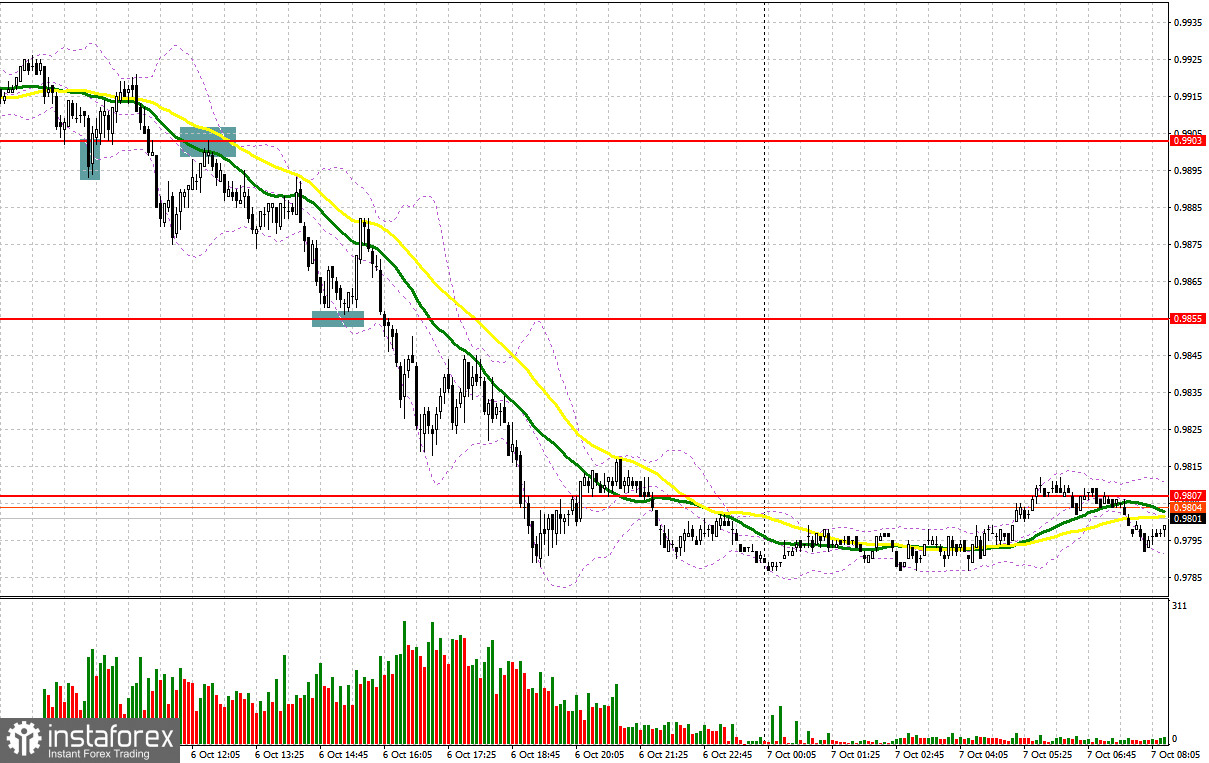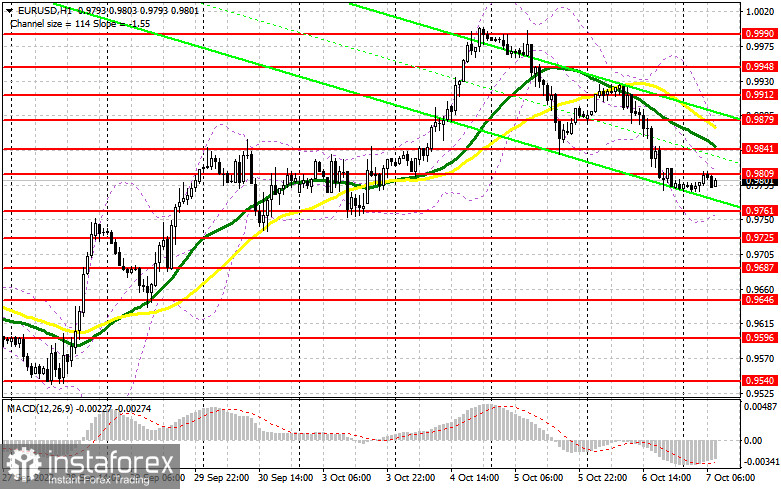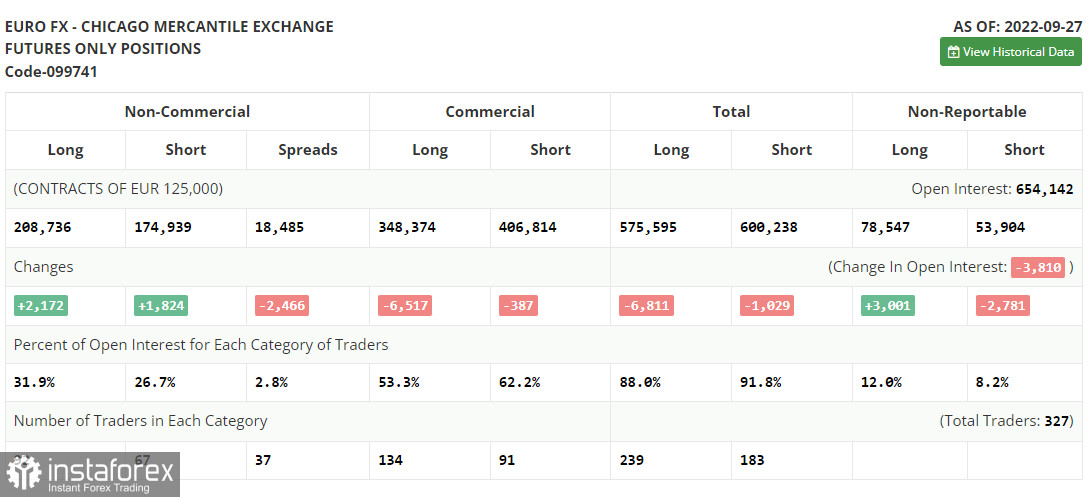Yesterday, there were several excellent entry points. Now, let's look at the 5-minute chart and try to figure out what actually happened. In the morning article, I turned your attention to the 0.9903 level and recommended making decisions with this level in focus. A decline to 0.9903 occurred rather quickly. After the first downward test, the bulls defended this level, giving a buy signal. The pair climbed by 17 pips. However, a breakout took place after the second test of 0.9903. It provided a good entry point into short positions, which resulted in a drop to 0.9855. The pair tumbled by 50 pips. A new buy signal appeared after a false breakout of 0.9855. The pair jumped by 20 pips.

Conditions for opening long positions on EUR/USD:
The pressure on the euro is likely to persist in the first half of the day. However, the bulls could act quite aggressively when approaching the nearest support level of 0.9761. Germany's Industrial production report or Retail Sales data will hardly affect the trajectory of the pair. Yet, weak figures may push it to 0.9761. A false breakout of this level will give a buy signal with the prospect of a rise to 0.9809. However, further movements of the pair will be clearer only after the release of the Nonfarm Payrolls report. Economists reckon that this report is a gauge for the Fed when making monetary policy decisions. So, this report may also significantly impact the future steps of the regulator on aggressive tightening. The bulls are likely to take the upper hand only after a breakout of 0.9809 and a downward test of this level. It will force the bears to close Stop Loss orders, providing an additional signal to open long positions with the possibility of a jump to 0.9841. However, even consolidation above this level will hardly trigger a trend reversal. Only a rise above 0.9841 and the resistance level of 0.9879 will weaken the bear market, which has been unfolding recently. A more distant target will be the resistance level of 0.9912 where I recommend locking in profits. If EUR/USD declines and bulls show no activity at 0.9761, the pressure on the euro will increase. It may fall to 0.9725. It is better to open long positions at this level after a false breakout occurs. You can buy EUR/USD immediately at a bounce from 0.9687 or 0.9646, keeping in mind an upward intraday correction of 30-35 pips.
Conditions for opening short positions on EUR/USD:
The bears managed to assert strength. Their main task for today is to protect the nearest resistance level of 0.9809. If the EU economic reports are downbeat, they are likely to do so. A false breakout of this level will give an excellent entry point into short positions, pushing the pair down to the 0.9761 level. A breakout below this level may occur only after the release of the NFP report. I advise selling from 0.9761 only after an upward test. It will generate an additional sell signal. Bulls will have to close Stop Loss orders. The pair could decline to 0.9725. A more distant target will be the 0.9687 level where I recommend locking profits. If EUR/USD climbs during the European session and bears show no energy at 0.9809, demand for the pair will increase. It may lead to a strong upward correction. In this case, it is better to cancel short positions until a false breakout of 0.9841 takes place. You can sell EUR/USD immediately at a bounce from a high of 0.9879 or 0.9912, keeping in mind a downward intraday correction of 30-35 pips.

COT report
According to the COT report from September 27, the number of both short and long positions increased. After the central banks' meetings, the euro was under considerable pressure caused by the comments provided by European and US politicians. However, the currency managed to cope with it and now it has every chance to cover, though for a short period of time. The fact is that inflation in the EU has already exceeded 10.0%. In autumn and winter, the situation will only aggravate. That is why the euro will hardly show considerable growth. The worsening geopolitical situation in the world, which is mainly affecting the eurozone, may cause a considerable slowdown in the local economy, which is likely to slip into a recession as early as next spring. Soon, the eurozone will disclose reports on activity in various sectors. A decline may cap the pair's upward potential. The COT report unveiled that the number of long non-commercial positions increased by 2,172 to 208,736, whereas the number of short non-commercial positions surged by 1,824 to 174,939. At the end of the week, the total non-commercial net position remained positive and amounted to 33,797 against 33,449. This indicates that investors are taking advantage of the moment and continue to buy the cheap euro below parity, as well as accumulate long positions, expecting the end of the crisis and the pair's recovery in the long term. The weekly closing price collapsed to 0.9657 from 1.0035.

Signals of technical indicators
Moving averages
EUR/USD is trading below 30- and 50-period moving averages. It means that the bears are trying to take control.
Remark. The author is analyzing the period and prices of moving averages on the 1-hour chart. So, it differs from the common definition of classic daily moving averages on the daily chart.
Bollinger Bands
If EUR/USD advances, the indicator's upper border at 0.9850 will act as resistance.
Definitions of technical indicators
- Moving average recognizes an ongoing trend through leveling out volatility and market noise. A 50-period moving average is plotted in yellow on the chart.
- Moving average identifies an ongoing trend through leveling out volatility and market noise. A 30-period moving average is displayed as the green line.
- MACD indicator represents a relationship between two moving averages that is a ratio of Moving Average Convergence/Divergence. The MACD is calculated by subtracting the 26-period Exponential Moving Average (EMA) from the 12-period EMA. A 9-day EMA of the MACD called the "signal line".
- Bollinger Bands is a momentum indicator. The upper and lower bands are typically 2 standard deviations +/- from a 20-day simple moving average.
- Non-commercial traders - speculators such as retail traders, hedge funds, and large institutions who use the futures market for speculative purposes and meet certain requirements.
- Non-commercial long positions represent the total long open position of non-commercial traders.
- Non-commercial short positions represent the total short open position of non-commercial traders.
- The overall non-commercial net position balance is the difference between the short and long positions of non-commercial traders.
 English
English 
 Русский
Русский Bahasa Indonesia
Bahasa Indonesia Bahasa Malay
Bahasa Malay ไทย
ไทย Español
Español Deutsch
Deutsch Български
Български Français
Français Tiếng Việt
Tiếng Việt 中文
中文 বাংলা
বাংলা हिन्दी
हिन्दी Čeština
Čeština Українська
Українська Română
Română

